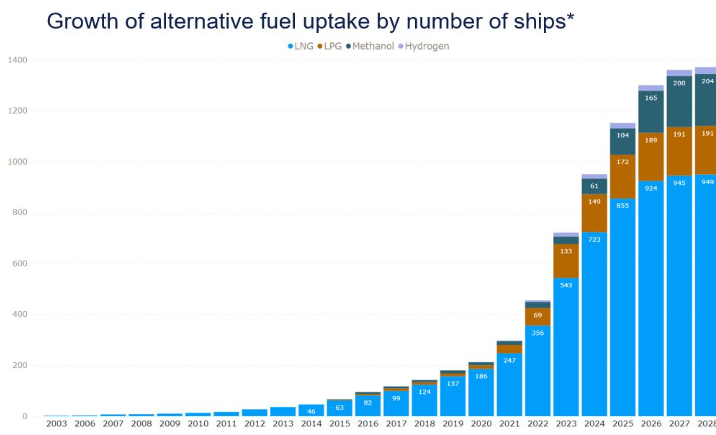Methanol is considered one of the alternative fuels that will drive shipping’s decarbonization. But with its ever-growing popularity, methanol is in the risk of loosing its alternative status, heading towards the mainstream.
In particular, according to Martin Christian Wold, Principal Consultant at DNV, DNV added 48 methanol-fuelled ships (including retrofits) to its Alternative Fuels Insight (AFI) database in July alone. Furthermore, the total number of methanol-powered ships has recently capped 200.

Methanol-fuelled orders
Wold goes on to say that the container segment remains the biggest fan of methanol. This comes as no surprise considering that, for instance, Maersk has 25 methanol-enabled vessels on order.
To remind, Maersk has already taken delivery of the world’s first dual-fuel methanol containership, which is currently on its way to Copenhagen, after receiving methanol during the world’s first ship-to-ship methanol bunkering operation at the Raffles Reserved Anchorage in Singapore.
Another example of this is that Evergreen revealed a massive fleet expansion plan in early July that includes the purchase of twenty-four 16,000 TEU methanol dual-fuelled containerships. In addition, Wärtsilä confirmed last week that it will supply methanol-fueled auxiliary engines for six CMA CGM newbuild container vessels.
Finally, in early June Eastaway, a member of the X-Press Feeders Group, ordered six 1,250 TEU container vessels, fitted with dual-fuel engines capable of operating on conventional fuel and methanol.
Retrofit solutions
The adoption of methanol as a maritime fuel does not stop at newbuilds. Engine retrofits are also a popular option. For example, MAN Energy Solutions recently signed a Conversion Commitment Agreement with Seaspan Corporation, in collaboration with Hapag-Lloyd, for dual-fuel, for 15 methanol engine retrofit solutions.
LNG
Except for methanol, liquified natural gas (LNG) orders are also on the rise, according to Wold. Fourteen LNG-fuelled ships were added to the AFI database in July. Moreover, Wold claims that the LNG orderbook was more diverse with car carriers and large tankers driving July’s growth.
However, container vessels were not left out with GTT announcing it has secured an order from Yangzijiang shipyard, to design the cryogenic fuel tanks of ten ultra large, LNG-fuelled container vessels.
As the International Gas Union (IGU) notes, there were 668 active vessels as of end-April 2023, including 45 FSRUs and eight floating storage units (FSUs). The global fleet grew by 4% with the delivery of 27 carriers in 2022.































































